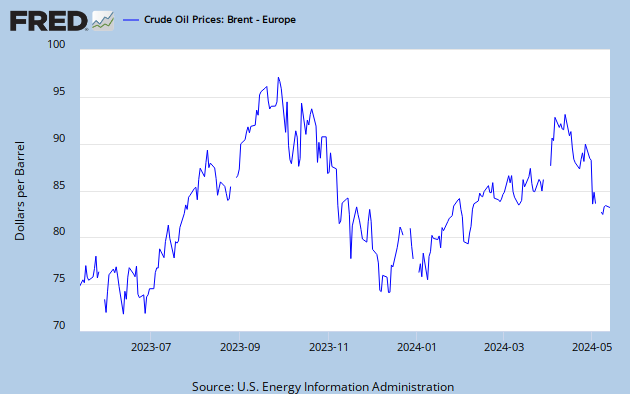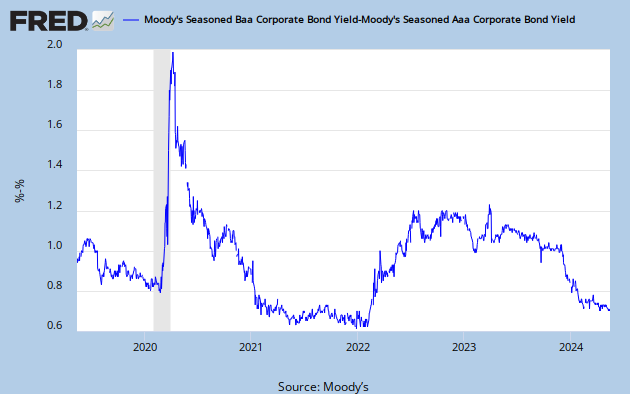Awash with liquidity and starved of paper, must financial markets slip out of control? This is the central question behind the “financial stability” argument against additional monetary easing. According to this objection, the zero bound on interest rates means that the Fed’s easing can do little for the real economy, and the cash created by open market operations just fuel a speculative excess termed a “reach for yield”. I have addressed
one reason why this theory is incorrect. If QE indeed spurred a reach for yield, then the taper talk should have reversed this and caused a flight to safety. Yet after the taper dust settled, we saw cyclicals rally strongly with safe assets falling -- indicating that QE was likely encouraging healthy risk taking and not an anomalous reach. However, this evidence primarily came from equities. In this post, I want to take a different approach to expand the scope of my argument against financial stability concerns. I will start with some monetary history and discuss why thinking in terms of financial stability can be very misleading. In short, adopting financial stability approach to monetary policy is unwise and will likely worsen both the business and financial cycle.
First, let’s consider the motivating evidence for the financial stability position. Below is a chart prepared by UM alumni
Naufal Sanaullah charting the loan deposit gap into US commercial banks. According to Naufal, this shows that the usual lending mechanism that we learn in intro macro doesn't work any more. No more loans are going out, and therefore nothing makes it to the real economy. And while the real economy is unaffected, this domestic savings glut drives a reach for yield as banks still need to pay their depositors.

If this theory is correct and monetary policy is completely ineffective, the Fed should taper earlier. If the costs to financial markets are great enough, and if the benefits to real economies are small enough, it may be worth it for the Fed to fumigate any excess risk in markets by raising interest rates.
Thinking in terms of financial stability may seem novel, but the Federal Reserve actually had the same debate during the Great Depression. Julio
Rotemberg, in his recent paper for the NBER monetary policy conference, does a wonderful job summarizing the literature on the thought process of the Fed at that time.
Friedman and Schwartz (1963) stressed instead the substantial declines in the money supply that followed. These were, in part, the result of the Fed’s refusal to lend to banks subject to runs. In addition, and in spite of the exhortations of various Federal Reserve officials at various times, *the Fed resisted embarking in large-scale open-market purchases to offset the declines in banking.8 Under pressure of Congress, such a program was started in April 1932, though it quickly ended in August of the same year. This was rationalized on the ground that conditions were “easy” since there were ample excess reserves. Some officials thought the increase in excess reserves (and reduction in borrowing from the Fed) proved that the program was ineffective.9*
Given subsequent developments, it seems likely that some members also viewed excess reserves with fear. As excess reserves accumulated in the mid-1930s these fears were openly discussed, and Friedman and Schwartz (1963, p. 523) quote extensively from a 1935 memo that clarifies their nature.* In effect, the Fed worried that banks would use these funds for speculative purposes that would ultimately be costly. *Or, as the 1937 Annual Report put it, the Board feared “an uncontrollable increase in credit in the future.”10 *These concerns were sufficiently intense that the Fed raised reserve requirements by 50% in August 1936. Further increases in 1937 left them at double their 1935 values (Meltzer 2003, p. 509).*
If you look closely, the parallels to the Fed’s dramatic QE policies and current financial stability concerns are uncanny. In both stories, the recession was identified as the result of speculative excess. In response to the crash, both times the Federal Reserve embarked on a program of monetary easing. However, in both instances excess reserves failed to budge, and this was interpreted as a sign that banks just didn’t want to lend -- the Fed was pushing on a string. Finally, as excess reserves persisted, the threat of “speculative purposes” was used to bully the Fed into tightening. The key difference between now and then is that we have a Fed that recognizes its role in supporting the real recovery. Those in 1936 were not as lucky.
Why did the Fed go on such a destructive path in the 1930’s? Rotemberg identifies the tightness of policy as a consequence of something called the “real bills doctrine”. Under the real bills doctrine, the Fed saw its role as providing credit so that there was enough, and no more, credit to invest in “productive uses”. Since the Great Depression was preceded by a speculative stock bubble, then Fed officials put a premium on making sure credit was put to “productive uses”; The real bills doctrine was the result. According to this doctrine, monetary policy should tighten in recessions when demand for credit falls so as to make sure what credit remains is put towards productive uses. Conversely, monetary policy should ease in booms because firms are looking to find credit to fund their projects. In other words, the real bills doctrine prescribed a procyclical monetary policy.
This goes to show that we need to avoid framing effects when thinking about monetary policy. Because the Great Depression was the result of an equity bubble, then the economists of the day were so concerned about bubbles that they pursued destructive monetary policy. It is just as important to not make the same mistake today. As the real bills doctrine shows, using the tools of financial economics to solve monetary problems can be very destructive.
In particular, the concern about excess reserves or a loan-deposit imbalance comes about from ignoring general equilibrium. Walras' law states that the value of excess demands add up to zero across all markets in an economy. So if there is a lack of demand in goods, it must be the result of an excess demand for money that goes into savings. But if the interest rate is low enough, it may no longer be worth it to hold onto the money as savings and people will spend it. In the limit, if people knew that all of their cash would disappear when the next day started, they would certainly spend today. There must be a real interest rate, perhaps negative, that would make people want to give up enough money to equilibrate the goods market. This conclusion now recasts the question to whether that negative rate is attainable. Once you can reach any arbitrary rate, then the money markets and good markets are sure to equilibrate.
Of course if the Fed was stuck at the current interest rate it could never attain the negative rate. But that’s where forward guidance comes into play. What forward guidance allows the Fed to do is pin down the future price level -- even if there appear to be no tools right now. This is the well known escape clause in Krugman’s original analysis of the liquidity
trap. If the Fed can commit to a future policy path, the zero lower bound no longer matters.
To get a more intuitive feel for this argument, you should think in terms of an observable Fed policy rate (r) and an unobservable Wicksellian, or full employment, rate (w). The full employment rate is so named because it is the interest rate at which all resources are fully employed. In this example, I set both interest rates to be nominal, so r cannot be lower the zero. At any given instance in time, the stance of monetary policy is determined by where the policy rate, r, is relative to the Wicksellian rate, w. If the Fed rate is higher than the Wicksellian rate, the Fed is tightening. If it is lower, the Fed is easing. Dynamically, the Fed's policy stance is determined by the blue area minus the red over all time.

This gives a natural interpretation for why forward guidance works at the zero lower bound. Even though the Fed’s rate, r, is stuck at zero and is currently above the Wicksellian rate w, the Fed can still generate inflation by promising to keep Fed policy easy in the future, even when the Wicksellian rate rises. This then can move the economy to a different equilibrium. With higher expected inflation, the nominal Wicksellian rate rises since means people are willing to part with their money (read: have no excess demand for money) at higher interest rates. As a result, even though the Fed is constrained right now, it still has power over the future policy path. This goes to show that the zero lower bound is not a serious reason to discount the Fed's ability to conduct monetary policy.

To get back on track, the Fed must commit to keeping rates low until the price (or nominal GDP) level is back to trend. On the other hand, if the Fed were to raise interest rates now, this would collapse expected inflation, lowering the Wicksellian curve and knocking the economy into a low output, low interest rates environment. So even if you think the low rates environment is causing financial distortions, the only way to get higher rates in the future and to solve the apparent financial distortions of low interest rates is, ironically, to promise to keeping short rates low now.
The financial stability view gets off track because it ignores general equilibrium effects. In partial equilibrium analysis, when there's an excess stock of something, such as bank reserves, the natural response is to cut supply. But this is misleading analogy for bank reserves, because an excess supply of bank reserves actually represents an excess demand for money. Therefore the proper response is to maintain lower rates and not prematurely tighten.
Therefore the real bills/financial stability doctrine fails for three reasons. First, it identifies excess reserves as the result of reduced borrowing that the Fed cannot control, whereas the excess reserves actually are symptoms of an excess demand for money that easier monetary policy can address. Second, this misdiagnosis means we are left thinking the Fed is powerless, whereas the Fed can pin down the price level through forward guidance. Third, it ignores the general equilibrium relationship between money and goods. By prematurely raising rates, this actually depresses interest rates in the long run and worsens the excess demand for money. Bottom line? Worrying too much about financial stability concerns can exacerbate the business cycle and actually prolong a period of low rates. Instead, the Fed should keep its eyes on the real economic prize, and keep financial decisions separate from its monetary ones.

























